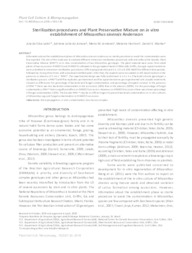Sterilization procedures and Plant Preservative Mixture on in vitro establishment of Miscanthus sinensis Andersson.
Sterilization procedures and Plant Preservative Mixture on in vitro establishment of Miscanthus sinensis Andersson.
Author(s): LEDO, A. da S.; AMARAL, A. L. do; JENDEREK, M. M.; HARRISON, M.; MANTER, D. K.
Summary: Information about the establishment phase of Miscanthus sinensis Andersson as sterile procedure to avoid the contamination were few reported. The aim of this study was to evaluate different immersion sterilization procedures with and without the biocide, Plant Preservative Mixture (PPM?) on in vitro contamination of two Miscanthus genotypes. The plant material were canes from adult plants of two accessions PI 668371 and PI 668375 cultivated in the germplasm bank of USDA-ARS, Griffin, Georgia. Apical meristems were submitted to immersion sterilization procedures (70% isopropyl alcohol and 1.5, 5.0 or 8.25% NaOCl for different time periods, followed by rinsing three times with autoclaved distilled water. After that, the explants were inoculated on MS basal medium in the presence or absence of 1 mL L-1 PPM?. The experimental design was fully randomized in a 2 x 5 x 2 factorial scheme (genotypes x sterilization process x PPM?) with five replicates per treatment and five apical meristems per experimental unit. Aseptic treatments showed no differences for percentage of bacterial and fungal contaminations and percentage of explant survival. In the presence of PPM ? there was less bacterial contamination in the accessions (28%) than in the absence (100%). For the percentage of fungal contamination, PPM ? had no significant effect on PI 668371 accession. However, on PI 668375 accession there was a lower percentage of fungal contamination (16%). The biocide PPM ? may be an efficient agent to prevent bacterial contamination on in vitro cultures of Miscanthus spp and fungal contamination in PI 668375 accession.
Publication year: 2019
Types of publication: Journal article
Keywords: Contaminação Fúngica, Cultura In Vitro, Micropropagação
Observation
Some of Embrapa's publications are published as ePub files. To read them, use or download one of the following free software options to your computer or mobile device. Android: Google Play Books; IOS: iBooks; Windows and Linux: Calibre.
Access other publications
Access the Agricultural Research Database (BDPA) to consult Embrapa's full library collection and records.
Visit Embrapa Bookstore to purchase books and other publications sold by Embrapa.

